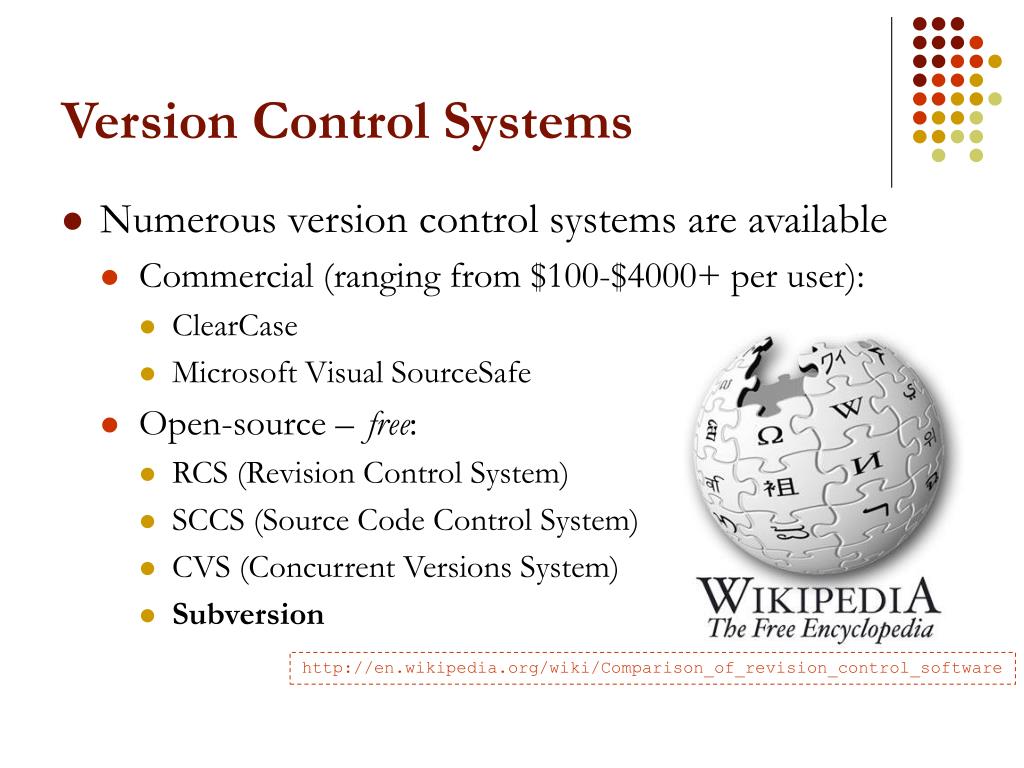
- SUBVERSION SOURCE CONTROL HOW TO
- SUBVERSION SOURCE CONTROL CODE
- SUBVERSION SOURCE CONTROL LICENSE
- SUBVERSION SOURCE CONTROL PROFESSIONAL
- SUBVERSION SOURCE CONTROL MAC
Hosted SVN takes the guesswork out of creating your repository and installing an SVN browser for it. WebSVN is in PHP, it’s portable, and it’s easy to install.Ī simple repository browser that allows for multiple repositories without browser or platform-specific extensions.įor those wanting a little more control over their repositories and a public face for their projects, hosted SVN might be a good solution. Here are a few scripts you can upload to your server to get a better interface for your project’s source code.
SUBVERSION SOURCE CONTROL CODE
By default, SVN just dumps source code into the most basic form of HTML and links. SVN repositories are pretty plain and don’t let you browse the code very easily. Trac is used in many open-source projects to manage workflow and is considered the standard for this purpose. Aside from letting you browse SVN repositories, Trac allows you to create wikis, track bugs and much more. Trac is much more than an SVN browser: it’s a complete project management tool.
SUBVERSION SOURCE CONTROL LICENSE
VisualSVN for Visual Basic by Microsoft isn’t open source a license costs $49. Subclipse is a plug-in for the Eclipse IDE for Java.ĪnkhSVN is an SVN client for Microsoft’s Visual Studio. If you already use an integrated development environment (IDE), then plug-ins are available to interface with SVN. While not technically an SVN client, the iPhone SVN Log Viewer allows you to keep track of commits and changes to your SVN repository in an iPhone app. Psvn.el is an SVN client for eMacs, a popular open-source text editor.
SUBVERSION SOURCE CONTROL MAC
Scplugin, also open source, is much like Tortoise SVN in that it uses the Finder on the Mac as an SVN interface. One of the stand-out features of Syncro SVN is its ability to let you quickly see revisions in the same pane. Subcommander is a cross-platform, open-source client that makes basic SVN functions quite easy to use.įSVS stands for “Fast System Versioning”, and this open-source command-line client does exactly that.Ī cross-platform SVN client with a fantastic UI.



Among its features are local history cache, various visualization tools and merging assistant. Approximately $49 USD.Īn open-source Eclipse plug-in providing support for Subversion within the Eclipse IDE. Versions is unique because it syncs with the online SVN repository Beanstalk. Versions is another SVN client with a beautiful interface.
SUBVERSION SOURCE CONTROL PROFESSIONAL
The client comes in free and professional versions, with the professional version starting at $79 USD. SmartSVN is another cross-platform SVN client, but targeted more at professional developers. Tortoise SVN is probably the most widely used Windows shell for SVN and is open source.Ĭross-platform SVN client built in Python. If you’re on a Windows machine, SVN 1-Click Setup will do just what the name implies: set up your SVN environment in one click with an installer. The documentation contains just about everything you’ll ever need and is a great reference tool. Once you’ve gotten the basics, check out SVN’s official documentation.
SUBVERSION SOURCE CONTROL HOW TO
It covers every topic related to SVN, from what SVN is to how to use it to advanced usage. Version Control with Subversion is an excellent book to start with. If you’re looking for a more concise version of how to set up SVN, this quick cheat sheet will get you well on your way.

Here are a few tutorials to get you started on the right track and ease the pain. If you’re just getting started with SVN, the hardest part is the learning curve. You might be interested in the following related posts: Getting Started with SVN There are quite a few resources available for those who want to learn about SVN-like tools, tutorials and SVN clients, so that you can get started working with the popular version control system. It’s also a great choice for designers who want to keep versions of their personal work environments. SVN provides the ability to share source code in a collaborative way, making it popular with teams for sharing and contributing to projects. While other version control systems, like Git, have become quite popular among developers, Subversion (SVN) is still considered the standard for version control systems and is used for the majority of projects on the Web that need something like it. Subversion was started in 2000 and is quite popular in the open-source community major repositories such as Google Code use it to distribute source code. Subversion is a version control system that many Web developers and designers use to back up their work.


 0 kommentar(er)
0 kommentar(er)
